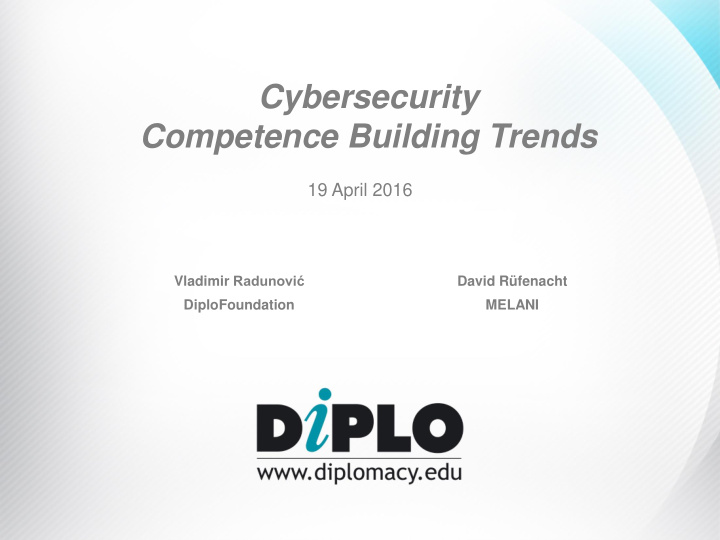



Cybersecurity Competence Building Trends 19 April 2016 Vladimir Radunović David Rüfenacht DiploFoundation MELANI
Context Challenges Opportunities • Threats to institutions, • Driver for employment • Economic growth business, CI • Multidisciplinary area • Global competitiveness (technology, law, diplomacy, economy, management, psychology, media) • Fast-changing environment
Context Developing national capacities and competences BY Transforming the national labour market to meet the changing environment BUT Building qualified labour goes beyond traditional education and one-off training courses
Research Inquiry : FDFA inquiry on ‘Promote cybersecurity competence building in Switzerland through lessons learned abroad’ Objective : contribute to strengthening cybersecurity skills and competences in Switzerland (especially re. CI) Task : Review of trends and policy instruments of 10 OECD countries on cyber competence building that could feed into NCS
Methodology Problem: developing human skills and competences through training and education for technological and organisational measures to counter cyber-threats Methodology : Qualitative research (July-October 2015) based on review of the literature, content analysis of (open) documents, secondary analysis and statistics Case selection : Pre-set countries : Estonia, Israel, Republic of Korea, the Netherlands, UK and US Added countries : Austria, Finland, France and Germany
Key findings Countries observe both risks and opportunities : cyber- preparedness and global industry competitiveness Combination of long-term and short-term approaches to transforming labour markets Trends heavily based on PPP (development of curricula, certification, capabilities, regional hubs): strategic lead and incentives by government funds and cutting-edge technology by private sector knowledge, outreach and research potential by academia
Lead trends Promoting competence building at universities University programs supported Labelling of Regional development by the government universities Competence building through professional training State Collaboration Improving the Manager and Knowledge personnel w/ professional competences of decision- frameworks, job training certification the private sector making level descriptions and bodies (SME and CI) training professionalization
University programs supported by the government • Strong PPP element • Supported by government (specific Ministry) • Economic growth is aimed • Long term development • Research Lab & Network development
University programs supported by the government
Labelling of universities • Student advantage (tuition fees) • University advantage (attract new students with image, potential facilitated research funding, research network, establishing programs) • Government advantage (training for future employees, screening of future employees, potential say to research directions) • Disadvantage: potential loss of independence and link with politics (real and/or reputational loss) Example: Center for Academic Excellence in Defense Education (CAE-CD) (US)
Labelling of universities
Regional development • Developing universities, research labs, innovation hubs, labs, joint ventures • Need for funding: regional development and use of national and supra-national and/or research funding (especially private sector) • Never a ‘totally’ new place: located in regions with lead universities and political and economic relevance • Depends on context and geopolitical situation Example: CyberSpark Industry Initiative at Ben-Gurion University in Be’er Sheva (Israel)
Regional development
State personnel training Extremes: state training vs private training Government regulatory institution trains specialists: Example : ESSI certificate by ANSSI- CFSSI (France) + control, highly specialized – costly, high labor toll on regulatory institution, potentially longer to adapt, workforce mobility Use of professional certification bodies: Example : US DoD Policy 8570.1 – 8410 requirements (US) + low cost of adaption certification (technical experts), ‘soft’ standardization (public-private, national-international), workforce mobility, workforce reallocation time – takes time to decide on providers and/or certificates, costly for trainees (financial)
State personnel training
Collaboration with professional certification bodies Creating a certificate for national needs + creates certificate adapted to national legal framework, advantages of professional certification bodies, – needs national legal framework (takes time, commitment), suited for national not international, and need for ‘critical size’ Example: BSI Cybersecurity Practitioner (Germany)
Collaboration with professional certification bodies
Improving the competences of the private sector • Especially for SME and CI • Incident handling and prevention framework (using professional certification bodies) • Frameworks and standards for private sector • Government subcontractors mandated to implement • Securing the chain • Awareness training Example: 'Cyber Essentials' - standards/ requirements and Certification for SME (UK) & 'Référent en cybersécurité' guide with standards by ANSSI (France)
Improving the competences of the private sector
Manager and decision-making level training • Addressing awareness among CEO & decision-makers • Multidisciplinary: politics, regulation, business management • Helps deciding on investments in IT and cybersecurity sectors in institutions • Need for quick and applied training Example: Executive Academy within CyberSpark (Israel) & Master’s degree in Cybersecurity at JyvSecTec (Finland)
Manager and decision-making level training
Knowledge frameworks and job descriptions • Lack of understanding of what is and what will become cyber competence • Defining tasks and required knowledge • Allowing for recombination and evolution • Helps employer, employee and HR for training management Example: 'National Cybersecurity Workforce Framework 2.0' by the National Initiative for Cybersecurity Education (US)
Knowledge frameworks and job descriptions
Conclusion
Full paper: www.diplomacy.edu/cybersecurity Contact: vladar@diplomacy.edu
Recommend
More recommend